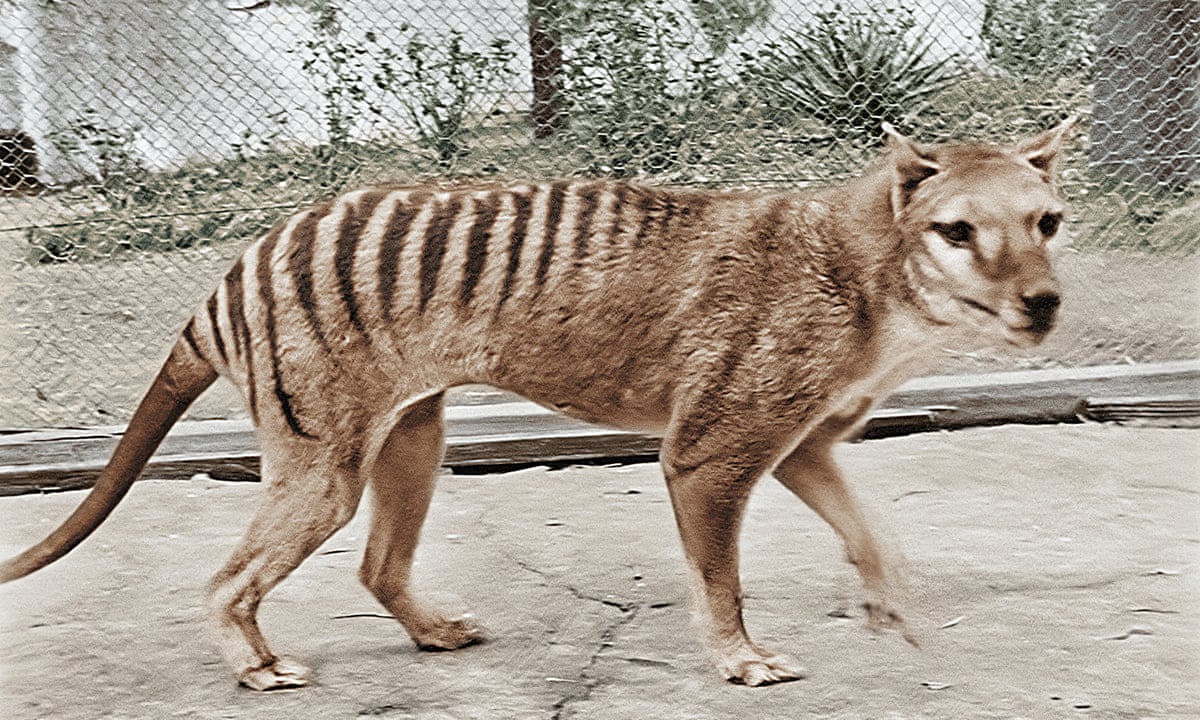Context
-
Scientists in the US and Australia have embarked on a $15-million project to resurrect the thylacine or Tasmanian Tiger, a marsupial that went extinct in the 1930s, using gene-editing technology. The ambitious project aims to reintroduce the animal to its native place Tasmania to revive the region’s lost ecological balance.
About Tasmanian Tiger
- Tasmanian Tiger (Thylacinus cynocephalus), the only animal in the Thylacinidae family to survive in modern times, was a marsupial mammal that raises young ones in a pouch.
Photo Credit; The Guardian - Even though the species earned its nickname Tasmanian Tiger because of the stripes along its back, it was a slow-paced carnivorous that usually hunted alone or in pairs at night. The sharply clawed animal had a dog-like head and ate kangaroos, other marsupials, small rodents, and birds.
- Once widespread in the grass and woodlands of continental Australia extending north to New Guinea and south to Tasmania, the animal’s fate changed after the European Colonisation of Australia.
- The animals were reported to have eaten poultry of farmers, and were killed following official authorisation.
- Apart from this, competition with another animal, the Dingo, is also considered a reason for its extinction.
- The last wild thylacine was killed between 1910 and 1920. Following this, the Australian government declared the thylacine a protected species in July 1936. But two months after the announcement, Benjamin, the last captive animal, died at the Beaumaris Zoo in Hobart. The official declaration of the animal’s extinction was in the 1980s.
Tasmanian Tiger and Food Chain
- The animal was at the top of the food chain, and hence played a significant role in balancing the ecosystem of its habitat by removing the weak animals and maintaining species diversity.
- Also known as the apex predator for the same reason, its disappearance from the food chain resulted in Trophic Downgrading — causal degradation of an ecosystem that occurs when higher trophic level animals are removed from the food chain, resulting in loss or exponential growth of other species.
- Trophic Downgrading also results in disruption of biogeochemical cycles, wildfires, growth of invasive species, and carbon sequestration, among other effects.
- As the thylacine was the only apex predator in its ecosystem, its absence impacted the Tasmanian Devil, which was almost wiped out by a facial tumour disease.
- The thylacine would have prevented this by removing sick and weak animals from the ecosystem, which would have eventually controlled the spread of the transmissible diseases.
- The fat-tailed dunnart is a mouse-like species in the Dasyuridae family in Australia. With an average body length of 2.4–3.5 inches, they are one of the smallest carnivorous marsupials.
De-extinction technology; possibilities and challenges
- De-extinction, or resurrection biology, is the method of creating a species that went extinct or is endangered, in order to revitalise ecological diversity and balance shattered due to reasons ranging from biodiversity loss to climate change.
- While cloning is the most widely used method of de-extinction, genome editing and selective breeding are also considered effective ways.
- The Pyrenean ibex, a subspecies of Spanish ibex, was one of the first extinct animals that have been resurrected using somatic cell nuclear transfer (SCNT), even though the baby Ibex died minutes after its birth from lung defect.
- Apart from Colossal’s project to resuscitate Woolly Mammoths and thylacines, a cooperation between the Dutch Foundation partnered with multiple universities, called Tauros Programme, is currently working to breed a cattle species similar to the extinct wild ancestor of domestic cattle, aurochs.
- Other candidates for de-extinction are Maclear’s rat, an extinct large rat species endemic to Christmas Island in the Indian Ocean, the passenger pigeon, a type of migratory bird in North America, and the quagga, which is a subspecies of plains zebra.
Reference: IE
Visit Abhiyan PEDIA (One of the Most Followed / Recommended) for UPSC Revisions: Click Here
IAS Abhiyan is now on Telegram: Click on the Below link to Join our Channels to stay Updated
IAS Abhiyan Official: Click Here to Join
For UPSC Mains Value Edition (Facts, Quotes, Best Practices, Case Studies): Click Here to Join


